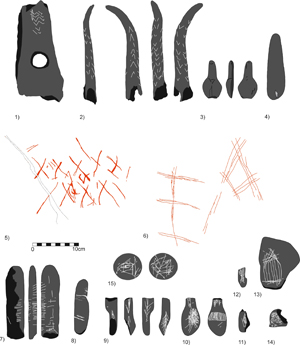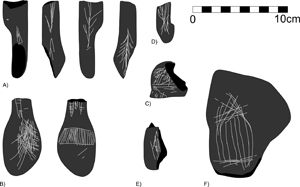
Although far from ubiquitous, decorative artwork is (sparsely) distributed throughout the archaeological record of the British Mesolithic, both spatially and temporally. Geometric patterns incised into material culture can be found on artefacts across the British Isles from Camas Daraich, Skye (Clarke et al. 2012), to Rhuddlan, Denbighshire (Quinnell et al. 1994), Trevose Head, Cornwall (Smith and Harris 1982) and Hammersmith, London (Smith 1934) (Figure 35). In addition to this, sculpture 'in the round' has been demonstrated through a stylised shale phallus from Nab Head, Pembrokeshire (David and Walker 2004), while an Early Mesolithic date has been suggested for two instances of incised cave art at Aveline's Hole and Long Hole, Somerset (Mullan and Wilson 2007).

Chronologically, dating evidence suggests that art is distributed throughout the Mesolithic. Accelerator Mass Spectrometry (AMS) radiocarbon determinations place artistic activities in the 9th, 8th and 7th millennia cal BC (see Table 1). However, at present, only the Llandegai pebble can potentially be linked to the 6th and 5th millennia cal BC, unlike in northern Europe where art exists during Late Mesolithic, Ertebølle contexts (Andersen 1981; 2001).
| Site | Type | Date | Calibrated | Dating notes |
|---|---|---|---|---|
| Hammersmith, London | Incised bone tool | OXA-17128 8505±45 BP | 7596-7508 cal BC | Direct AMS date on decorated artefact |
| Romsey, Hampshire | Incised antler | OxA-17161 8517±40 BP | 7595-7522 cal BC | Direct AMS date on decorated artefact |
| Aveline's Hole, Somerset | Incised cave art | Multiple | 8460-8140 cal BC | Modelled date for the cessation of activity and sealing of the cave - potential to be earlier |
| Long Hole, Somerset | Incised cave art | ?Early Mesolithic | No associated dates | Early Mesolithic material within the cave |
| Nab Head, Pembrokeshire | Shale beads and sculpture | OxA-1495 9210±80 BP OxA-1496 9110±80 BP | 8623-8283 cal BC 8567-8021 cal BC | |
| Rhuddlan M, Denbighshire | Incised pebble | BM-822 8528±73 | 7728-7426 cal BC | Date on bulked hazelnut fragments from within feature M90 containing one of the pebbles. Associated microliths suggest this may be too young. |
| Trevose Head, Cornwall | Incised pebble | Mixed Meso/Neo context | No associated dates | |
| Camas Daraich, Skye | Incised tool | 7545±55 BP 7574±75 BP | 6481-6251, 6591-6254 cal BC | Dates cited in Clarke et al. (2012, 3) |
| Llandegai, Bangor | Incised pebble | 4100-3900 cal BC | Inferred from association with rod microlith and Early Neolithic pottery (Griffiths 2014; Lynch and Musson 2001) |
While several authors note the presence of these expressive practices within Mesolithic Britain, few have offered interpretations for the meaning behind these actions. By far the most debated piece of material culture in relation to British Mesolithic art is the Nab Head shale 'amulet'. The original excavator rather prudishly described this as a 'duck-head' (although later conceded that it may in fact be a 'venus phallica' (Gordon-Williams 1926). Abbé Breuil took an interest in the object noting the similarities to both a phallus and the hips and waist of a woman. This led Breuil to interpret it as a coded jeu de mots, blending references to gender and fertility (Breuil 1955). Jacobi (1980) identifies a further piece of shale within the Nab Head assemblage that shows signs of working, and he links this to more stylised representations of the female form. The context of deposition of the Nab Head 'phallus' has also been noted, apparently having been placed into the ground alongside nine shale beads (Chatterton 2003).
Clark (Clark 1936) linked the chevrons observed on the Romsey decorated antler and Hammersmith bone adze to similar artistic patterns from across Europe. He states that they were created through incision with a fine and sharp tool, and that these methods of decoration are exemplified by the assemblages of Sværdborg and Holmegård in Denmark (Clark 1936, 162). These form part of a wider group of bone and antler artefacts featuring 'single chevrons often one placed above another' which are 'scattered indiscriminately over the whole of the North European plain' (Clark 1936, 172). However, owing to the isolated nature of this form of osseous material culture decoration within Britain, Clark was unable to draw any more meaningful parallels between the British examples and other sites, and only included them in his consideration of art on the basis of 'conjecture' (Clark 1936, 162).

Berridge (Berridge and Roberts 1994) provides some of the most detailed and direct discussion of the artwork from Rhuddlan, linking the finds from secondary deposits with an example from a dated Mesolithic context through the microscopic study of the methods of decoration (Figure 36). He notes that two distinct clusters of incised lines on SF1 and SF2 can be considered as 'motifs' for the sake of analysis - and that the form of these motifs have very close parallels elsewhere in Mesolithic Europe. He contests Miles' (1972) earlier suggestion that, in its entirety, SF2 can be interpreted as an anthropomorphic figure with clothes, as this bucks the broader trend of north-west European Mesolithic art. This interpretation requires a consideration of the overall form of the pebble as well as the separate motifs working together to form a complete, stylised figure - two characteristics that are deemed atypical of the wider body of Mesolithic artwork. Jacobi (pers. comm. in Berridge and Roberts 1994) tentatively suggests that the shape depicted on SF6 may reference a fish trap, and notes the strong formal similarity between this specific design and the structure of wooden fish traps from the Late Mesolithic sites of Lille Knabstrup and Nidløse, Zealand in Denmark.
Clarke et al. (2012) provide a methodical discussion of a series of lines incised along the edges of a bevelled pebble tool from Camas Daraich, Skye. They note the lack of similarities between the form of the incisions and the more widely recognised net patterns, zoomorphs or anthropomorphic figures observed elsewhere in European Mesolithic artwork. They also note that the lines are unlikely to communicate individual ownership, as these areas would be covered and thus invisible if the object were hafted or bound. Instead, they lean towards the incisions being representations of binding; guides for where and how an object should be bound which serve a quasi-functional purpose in providing purchase for binding materials. While this interpretation is presented tentatively, Clarke et al. (2012) note the lack of discussion of many of these themes within broader discourses of the British Mesolithic.